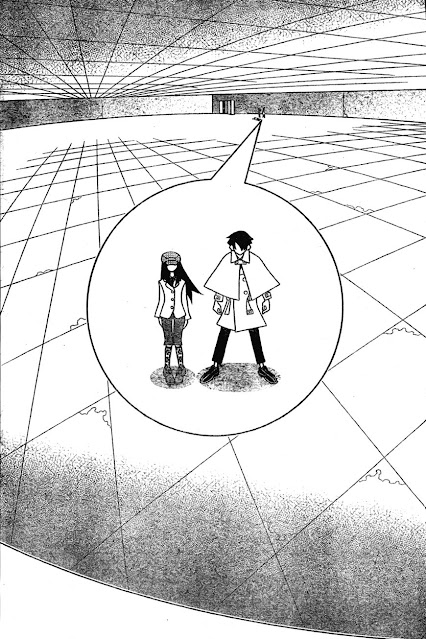If there is one year I wouldn't want to relive in the future, it would probably be 2021. The deaths of dear friends and numerous casualties among my near and dear ones owing to COVID-19, some recurring health issues (both physical and mental)—this year, the losses have been too many to count and bear.
By November, I thought I had left all of these behind, but then came the calling of a new job and, with it, the shift to a new city that left me severely ill. Settling at a new place and figuring out the logistics of my new workplace also took up a fair amount of time, as a result of which I wasn't able to pay any attention, whatsoever, to this blog for a month-and-a-half.
Amidst all these hardships, I suppose I owe a debt of gratitude to one of the most hilarious parodic one-shot mystery manga I have had the pleasure of reading which brightened many a dull and dreary evening. Kumeta Kōji's Shitauke Tantei Nokori Kasuhiro (The Cases of Contract Detective Nokori Kasuhiro: Foreign Student in a Locked Room) was the first entry in a collaboration series between art magazines Mephisto and Magazine on the theme of 'locked rooms'. Kōji is well known for his work on Sayonara, Zetsubou-Sensei, a manga series with a suicidal teacher as the protagonist (and his 'students' as the cast), known for its whimsical absurdism, running gags, dark humour, literary references as well as the eccentric analysis of Japanese society and culture.
Kōji's brand of morbid humour and his use of running gags are made evident in this one-shot manga at the very outset of Shitauke Tantei Nokori Kasuhiro. Kasuhiro Nokori is introduced as a contract detective who takes up cases that are simply too 'annoying' for other well-known detectives such as Conan, Kindaichi and Sherdock to solve. It is his assistant Shiyori Jigo who accepts the case the great Nokori will solve within 20-odd pages. From here on, Kōji pokes fun at crime fiction tropes and conventions in side-splitting fashion. To achieve this, Kōji 'elevates' the tropes and conventions to ridiculous, parodic extremes. For instance, in the narration of Kasuhiro's achievements, Shiyori mentions 'legendary' cases which Kasuhiro has solved by (i) making a hundred round trips of the same train route, (ii) adopting a De Niro-like approach and losing 20 kilograms of weight to solve an incident that happened via an opening too narrow for anyone to pass through, and (iii) diving into a barrel of grated yam that left the detective filling itchy for the following two months. Then, there's the introduction of the stock inspector character, who rules everything as a suicide and is thus named 'suicide officer' Shintarou Mizukara.
Perhaps, even more ludicrous is the setting of the locked room. Surely, it has to go into the annals of crime fiction as the largest locked room—a square, five-kilometre-by-five-kilometre room where the victim, the suspect, the witness and the murder weapon lying at each of the four corners of this gigantic room. At this point, Nokori starts to realise why the other detectives may have given up on this case (there's a hidden meaning to this, though, and things are not what they may seem at first glance), and indeed, it is possible for one to feel sorry for the detective having to travel to each corner and back, multiple times, to connect the threads of information gleaned from the respective corners. But Kōji never lets go of his sense of humour, and the way he portrays the deduction scenes, especially how a 'runner's high' helps solve the case, will more likely leave you doubled up in laughter than feeling sorry.
 |
| Ladies and gentlemen, the world's largest literary locked room, courtesy Kumeta Kōji and Shitauke Tantei Nokori Kasuhiro |
But, laughs aside, Shitauke Tantei Nokori Kasuhiro is an extremely competent mystery with a killer ending, even though it may seem to come slightly out of left field. Admittedly, the clueing and background information are a bit lacking, but there's only that much you can do within 20 pages. These shortcomings are more than compensated by the first-class deception and misdirection that leads directly into the devastating ending which hits the reader like a ton of bricks. What impresses me most about this one-shot is that nearly all the visual elements (the settings, the characters, the material evidences) that are so ruthlessly parodied also hide sinister meanings and implications behind their apparently ludicrous presence. One can sense Kōji's love and faithfulness towards the parody and crime genres, and it is to his immense credit that he is able to successfully merge the two in such a packed space. Ultimately, he pulls off a sensational and brilliant subversion of the locked room sub-genre using the duality of the synergistic elements he portrays—one where the mystery 'inside' the room matters little in comparison to what's happened 'outside' the room, even though the clues to realise the 'outside' events are all locked 'inside' the massive room.
In the last page, Kōji mentions that he would have loved to make this into a series, but this one-shot already seems to be the last chapter. A lost opportunity, I am sure, for us crime-fiction lovers, but I can sense a kind of resonance between my blog's plight and Kōji's unfulfilled manga series featuring the eccentric Kasuhiro Nokori. Moving forward, I am not sure how regular I will be with my writing on this blog, but as long as fulfilling reads such as Shitauke Tantei Nokori Kasuhiro come to my notice, there is always hope. Never say never, as they say.


No comments:
Post a Comment